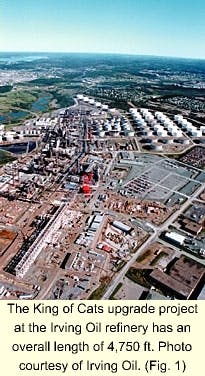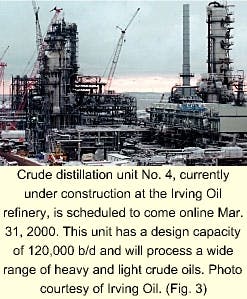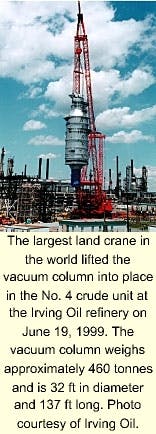Owners of Irving Oil Ltd.'s refinery in Saint John, NB, aim to increase economic and environmental performance by investing in a $1-billion (Can.) upgrade currently under way.
The upgrade is the largest and most expensive project in the facility's history. It is also one of the largest refinery projects in progress in North America.
This project is one step in Irving Oil's plan to ensure that it meets the 2005 target for sulfur in gasoline by 2002. This refinery upgrade is expected to be completed in the fall of this year.
Every dollar created by upgrade-related employment is projected to generate an additional $2-3 in economic activity in the form of spinoffs. The spending associated with the upgrade will increase New Brunswick's gross domestic product (GDP) by 2%.
Irving Oil refers to the upgrade as "King of Cats," in reference to a 70,000 b/d capacity resid fluid catalytic cracking unit (RFCCU), or "resid cat" unit, being built as part of the project.
Background
Situated on a 780-acre site (Fig. 1), the Irving Oil refinery can handle a variety of crudes and has the ability to produce a diverse range of petroleum products, including high octane gasolines, jet fuel, diesel fuel, home heating oil, propane, kerosine, and asphalt.
The facility has the largest volume throughput and is one of the most energy-efficient refineries in Canada. Benchmarks established by Solomon Associates Inc. rank it as one of the best performing refineries in North America.
The refinery opened on July 20, 1960, with an original capacity of 40,000 b/d. An expansion in 1971 increased capacity to 120,000 b/d. Another expansion in 1974 increased capacity to 250,000 b/d, where it stands today.
In the past decade, Irving Oil has invested more than $250 million on upgrades, improving overall efficiency and environmental controls. These improvements increased octane levels of gasoline, made Irving Oil the producer of gasoline with the lowest sulfur in Atlantic Canada, increased production, and improved environmental performance.
Irving Oil was the first company in Canada to remove lead from its gasoline and the first in Atlantic Canada to offer low-sulfur premium diesel fuel.
Purpose
The prospect of tougher environmental controls for products in Canada and New England is one of the determining factors in the company's decision to proceed with the upgrade.
Product values on global petroleum markets and the likelihood of variations in future crude supplies, as new reserves are developed and existing ones depleted, are two other key factors.
Designed with these considerations in mind, the refinery upgrade project will result in:
- Increased efficiency.
- Greater flexibility in converting low-value heavy fuel (bottom of the barrel) oils to higher value transportation fuels such as gasoline and diesel.
- Enhanced environmental performance resulting from reduced sulfur emissions.
- The ability to process a wider range of light and heavy feedstocks, including high-acid crudes in large volumes and both sweet and sour crudes.
On Oct. 14, 1999, Irving Oil was the first and only refiner and marketer in Canada to receive the official endorsement of Canada's leading auto manufacturers for producing low-sulfur, clean gasoline that maximizes engine performance and emission-control efficiency for today's low-emission vehicles. Mainly, Irving Oil's low sulfur specifications qualified it for the award.
Detergents minimize deposit build up in fuel injectors and intake valves, reduce combustion chamber deposits, and enhance emissions-control performance.
Auto industry tests require gasolines to have low sulfur levels (average 150 ppm) to meet improved "driveability" requirements. Driveability includes excellent vehicle cold start, warm-up driving, and emissions performance.
Environment Canada, a department of the Canadian government, supports federal regulations limiting the sulfur level in gasoline to an average of 150 ppm between 2002 and 2004. It anticipates a further reduction to 30 ppm by 2005.
Gasoline refined at the Irving Oil refinery meets the 2002 standard today, and the $1-billion upgrade is a step towards producing gasoline that meets the 2005 target for reduced sulfur in gasoline by 2002.
Kenneth Irving, one of the owners of Irving Oil, says that the company chose to step out ahead of government and industry deliberations and "set standards we knew were directionally right."
The upgrade will also enhance the refinery's ability to use Sable Island natural gas as a feedstock. Two years ago, Irving Oil agreed to purchase $1 billion of the initial Sable Island natural gas production.
In addition to using natural gas at the refinery, the company will market natural gas to customers in New Brunswick and Nova Scotia when the fuel becomes available in Atlantic Canada later this year.
Project scope
The $1-billion upgrade at the Irving Oil refinery builds on previous investments in the facility.
King of Cats is adding several units to the refinery to enhance production capabilities and improve efficiency. Also, the project will decrease overall sulfur dioxide (SO2) emissions and increase the reliability of environmental controls.
Fig. 2 shows how the new units will be integrated with the existing Irving Oil refinery. The upgrade consists of the following:
- Three process units: a crude distillation unit (CDU), an RFCCU, and an alkylation unit.
- Five environmental units: a flue-gas scrubber, a sulfuric acid regeneration unit, a sulfur plant tail-gas unit, an amine sulfur-recovery unit, and a sour-water stripping unit.
- The outside batteries limits (OSBL) facilities, which include the refinery's interconnecting piping, utilities infrastructure, cooling tower, firewater and fresh water pumps, and electrical substation.
- Modification of existing facilities, utilities, off sites, and infrastructure needed to support the project.
The new environmental units will reduce point-source emissions and increase the reliability of environmental controls. One of the self-imposed standards for the project design is that there be no increase in SO2 emissions and that an approximate 15% reduction in the emissions limit be achieved in the first few years of operation.
The refinery already operates below the New Brunswick government's cap on SO2 emissions.
Irving Oil also plans to review the refinery's performance with the New Brunswick Department of Environment and community stakeholders to assess targets after 5 years of upgraded operations.
By building environmental units with the flexibility to operate with either the new equipment or the existing units, the refinery enhances the reliability of its environmental operations.
For example, the new amine sulfur-recovery unit will operate in conjunction with the existing amine unit to provide the refinery with additional capacity, duplication, and flexibility in the absorption of hydrogen sulfide (H2S) from refinery fuel gas.
Concurrent with the construction of the new process units, the refinery is upgrading its wastewater treatment plant to accommodate the needs of the upgraded facility.
An essential component of Irving Oil's long-range strategy and its regional emphasis is a commitment to environmental protection. Bob Chalmers, Irving Oil refinery general manager, says "The owners believe that you can enhance a refinery's competitive position while at the same time improving environmental controls."
New units
Preliminary work on the King of Cats refinery upgrade started in the early 1990s. The first studies aimed at developing the optimum configuration for the proposed upgraded refinery.
Once the optimum size and type of process units were determined, the project team developed the technical scope of each process unit in sufficient detail to establish preliminary schedules. The result of this work was a series of preliminary design packages that form the basis of the engineering, procurement, and construction (EPC) effort now under way.
The scope of King of Cats consists of several new process units:
- CDU No. 4 is scheduled to come online on Mar. 31, 2000 (Fig. 3). The crude unit has a design capacity of 120,000 b/d. It will allow the refinery to process a wider range of heavy and light crude oil types. The unit will use 317L stainless steel, which will permit it to process crudes high in naphthenic acid.
The unit's atmospheric column is designed to operate in two different modes: maximum naphtha or maximum jet fuel. Design specifications enable the unit to operate for 5 years between scheduled turnarounds.
Reduced crude from the atmospheric unit will be feed for the vacuum unit. Deep cut technology from KBC Advanced Technologies plc, Weybridge, UK, will enable the vacuum unit to run at very low vacuum levels to reduce bottoms production.
The vacuum unit will recover vacuum gas oils (VGO) from the reduced crude. The gas oils will be feed for the hydrocracker, existing fluid catalytic cracker, and the new RFCCU.
- The RFCCU, with a capacity of 70,000 b/d, will share a common flue gas scrubber and stack with the crude oil distillation unit.
Stone & Webster Engineering Corp., Houston, is licensing its technology for the RFCCU. The main fractionator of the RFCCU will produce several streams: sour fuel gas and LPG to be sent to gas recovery, a wide range of gasoline to be sent to the gasoline desulfurization unit, light cycle oil to be sent to the diesel hydrotreater, and decant oil to be sent to the fuel oil blending pool.
- The alkylation unit, licensed by Stratco Inc., Leawood, Kan., will be a near duplicate of the existing one that came online in 1990. It will have an 8,000 b/d capacity of alkylate production. The new unit will have no fired heaters and therefore, no air emissions except volatile organic compounds, which are minimized by application of low loss engineering standards.
Sulfuric acid will be the catalyst instead of the less-costly hydrofluoric acid. Irving Oil made the decision on catalyst based solely on safety and environmental concerns.
The extra unit will double the refinery' alkylation capacity, thereby increasing its ability to produce more high-grade transportation fuels.
- Flue gases from the crude unit and RFCC will be routed to a new wet scrubber. The scrubber is the best available technology to control particulate emissions and is designed to meet the US Environmental Protection Agency's new-source performance standards for petroleum refineries.
- The sulfuric acid-regeneration unit will take the spent sulfuric acid from the two alkylation units. The regeneration unit will regenerate the acid for reuse in the alkylation units through a series of reactions that also removes 99 wt % SO2 from the acid gas.
It will use a proprietary technology called WSA process from Haldor Topsøe, Denmark.
Spent acid is currently exported from New Brunswick for regeneration at a relatively high freight cost. This new unit will significantly reduce both rail traffic and SO2 emissions. It will virtually eliminate the need to import fresh acid and eliminate the need to export spent acid off-site.
- The sulfur plant tail-gas unit employs similar technology to the sulfuric acid regeneration unit and will be placed in line with the sulfur plants. This unit will clean the stack gases before emission into the atmosphere.
- The amine sulfur-recovery unit will operate in parallel with the existing amine unit and will absorb hydrogen sulfide from refinery fuel gas and then send it to the existing sulfur plants for treatment.
The decision to build a new amine sulfur-recovery unit rather than increase the capacity of the existing one was made to provide additional capacity, reliability, and flexibility in operations.
- The sour-water stripping unit is another duplicate environmental control unit. It will operate in parallel with the existing unit to remove hydrogen sulfide and ammonia from process water.
Stripped sour water will either be reused in the crude unit desalters or handled in the waste water treatment plant.
Support projects
The new process units will increase the volume of refinery products, necessitating changes to the refinery's existing infrastructure.
The refinery will expand existing support systems such as water, steam, and electrical utility systems as well as shipping and blending systems.
Support projects include:
- Two new heat-recovery steam generators, which can be converted to future cogeneration units.
- A new deaerator.
- A demineralization facility.
- Two new 25,000-bbl LPG storage spheres.
- New shipping and blending facilities.
- Modifications to gasoline, diesel, and black-oil tankage.
- Conversion of an existing Penex unit to a Butamer unit, both licensed by UOP.
- Conversion of an existing diesel hydrodesulfurization (HDS) unit to employ dewaxing technology. This will allow production of low pour point diesel for the winter season. Akzo Nobel, The Netherlands, is providing the technology.
- Debottleneck of the existing hydrogen plant.
- A project to pipe natural gas into the facility to use as fuel.
Project details
Although several major contractors were involved in the preliminary engineering work, responsibility for the execution of the entire EPC phase of the project was awarded to engineering contractor Fluor Daniel. Fluor Daniel began detailed engineering work on the new CDU in February 1998.
Early in the planning phases of the project, Irving Oil decided to build the various process units with different on-stream dates, which allows flexibility in leveling of construction workforces. For example, CDU No. 4 is scheduled to be up and running some 6 months before the RFCCU comes on stream in October 2000.
The upgrade project was designed using an advanced 3D CAD system called Intergraph PDS, or Plant Design System. It generates a sophisticated computer model of each unit that can be viewed from any angle. The system reduces construction costs by automatically checking for interference and avoiding costly corrections in the field.
A second 3D CAD system, Invision, tracks and records construction progress. Fig. 4 is the model built by this system for the crude unit.
The upgrade project is experiencing a rework rate of 1.5%, low compared with Canadian construction industry's historical average of 5-10%.
As of mid-January, 2,400 tradespeople and 500 support, supervisory, and engineering staff members were working on site, and the upgrade project was 50% complete. The crude unit and OSBL were 70% complete with plans in place to support completion of these units.
The majority of civil and foundation work was complete in all areas except the new alkylation and tail-gas units. Worldwide procurement activities resulted in major equipment orders being placed in such diverse locations as Japan, Korea, and Spain.
The King of Cats upgrade project has an overall length of 4,750 ft, and these pipe ways physically define the overall length and breadth of the project.
As of the middle of January, the project was achieving a 5.2 recordable injury rate, less than half the Canadian National Safety Council's 10.5 average for the construction industry.
The project's lost time accident frequency was only 0.7, less than 15% of the Canadian National Safety Council's average of 4.9.
Community relations
Irving Oil is minimizing its construction impacts on the environment and refinery neighbors by using several industry-proven techniques. It is using dust control on roads for heavy-haul equipment and low-sulfur fuel in construction machinery.
In areas where water run off connects with the existing water-treatment system, Irving Oil has installed sewer lines. Limiting work hours of noisy activities, such as pile driving, also minimized community impact.
To optimize the size of the modules that could be transported to the construction site, Irving Oil designed and built a heavy-haul road running from the Saint John shipbuilding wharf to the construction site road. This road eliminates any impact on public roads. Large equipment and modules can be transported directly from the ship to the foundation.
As part of the refinery's ongoing community awareness program, the King of Cats project created a community awareness liaison committee consisting of 15 representatives from neighborhoods, businesses, and institutions located near the refinery. The committee's mandate is to assess environment-related issues associated with construction, make recommendations to Irving Oil, and communicate progress to the community. n
The Author
Daniel Goodwin works in the communications department of Irving Oil. He has written on the Irving Oil refinery for newspapers in Atlantic Canada and for the company's corporate magazine, East by Northeast. Goodwin holds an MA in English from Concordia University, Montreal.
Heavy-lift crane at work at Saint John refinery
On June 19, 1999, a new 460-tonne vacuum distillation column was lifted into place in Irving Oil Ltd.'s crude unit by the largest lift capacity, mobile land-based crane in the world. The 2,000-tonne crane, owned and operated by Van Seumeren Holland BV, is a breakthrough in heavy-lift crane design. It can be taken apart and transported in sections of 20 to 40 ft and fits in 84 railway containers.
The crane is unofficially christened "Beatrix," after the Queen of Holland. On July 4, Beatrix walked on her own tracks for the first time ever. Previously, the crane had been disassembled and moved to its next location, even on the same construction site, where it was reassembled.
Van Seumeren designed a track system for the crane that enabled it be moved without reassembly. As a result, a move that would have taken 10 days was shortened to 1 day. On July 10, after this first move, Beatrix lifted the new 279-tonne crude atmospheric column into place.







